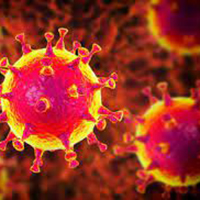Association of cycle threshold values of CBNAAT with severity and outcome in COVID-19

Submitted: January 3, 2021
Accepted: June 8, 2021
Published: July 21, 2021
Accepted: June 8, 2021
Abstract Views: 1865
PDF: 877
Publisher's note
All claims expressed in this article are solely those of the authors and do not necessarily represent those of their affiliated organizations, or those of the publisher, the editors and the reviewers. Any product that may be evaluated in this article or claim that may be made by its manufacturer is not guaranteed or endorsed by the publisher.
All claims expressed in this article are solely those of the authors and do not necessarily represent those of their affiliated organizations, or those of the publisher, the editors and the reviewers. Any product that may be evaluated in this article or claim that may be made by its manufacturer is not guaranteed or endorsed by the publisher.
Similar Articles
- Neeta Singla, Amitesh Gupta, U.K. Khalid, Ravindra Kumar Dewan, Rupak Singla, Clinical profile, risk factors, disease severity, and outcome for COVID-19 disease in patients with tuberculosis on treatment under the National Tuberculosis Elimination Program: a cohort of 1400 patients , Monaldi Archives for Chest Disease: Early Access
- Amrutha S, Komaldeep Kaur, Deepak Aggarwal, Mandeep Kaur Sodhi, Shivani Jaswal, Varinder Saini, Serial evaluation of antibody titres in patients recovered from COVID-19 and their correlation with disease severity , Monaldi Archives for Chest Disease: Vol. 94 No. 4 (2024)
- Unnati Desai, Ketaki Utpat, Aravind Raj, The impact of the COVID-19 pandemic on the profile of interstitial lung disease presenting to the pulmonary medicine department of a tertiary care center in western India , Monaldi Archives for Chest Disease: Early Access
- Frederico Ribeiro Neto, Juliane Machado Marques, Matheus Brasiliano da Paz, Eduardo Boiteux Uchôa Cavalcanti, Rodrigo Rodrigues Gomes Costa, Sit-to-stand test and handgrip strength in men and women with post-COVID-19 syndrome without invasive ventilator support: insights from a Brazilian observational study , Monaldi Archives for Chest Disease: Vol. 94 No. 3 (2024)
- Gaukhar Kurmanova, Almas Zhanaev, Akzharkyn Kaldybek, Balkiya Abdrakhmanova, Almira Akparova, Impact of the COVID-19 pandemic on the clinical features of patients with chronic obstructive pulmonary disease: an observational cross-sectional study , Monaldi Archives for Chest Disease: Early Access
- Angelica Cersosimo, Mattia Di Pasquale, Gianmarco Arabia, Marco Metra, Enrico Vizzardi, COVID myocarditis: a review of the literature , Monaldi Archives for Chest Disease: Vol. 94 No. 4 (2024)
- Sunny Kumar, Saurabh Mehra, Mrinal Sircar, Onkar Jha, Rajesh Gupta, Seema Sinha, Ravneet Kaur, Evaluation of the efficacy of convalescent plasma in moderate to severe COVID-19 during 2020-2021: a retrospective observational study , Monaldi Archives for Chest Disease: Early Access
- Megha Hegde, Saurav Raj, Dhananjay Tikadar, Sanatkumar B Nyamagoud, Unveiling vaccine safety: a narrative review of pharmacovigilance in India’s COVID-19 vaccination , Monaldi Archives for Chest Disease: Vol. 94 No. 4 (2024)
- Matteo Vigna, Piero Ceriana, Mara Santomassimo, Michele Vitacca, Mauro Maniscalco, Nicolino Ambrosino, Effects of pulmonary rehabilitation in survivors of severe acute respiratory syndrome coronavirus 2. Role of vaccination , Monaldi Archives for Chest Disease: Vol. 94 No. 3 (2024)
- Andrea Segreti, Francesco Piccirillo, Simone Pasquale Crispino, Francesca Cocchia, Arianna Martucciello, Vito Calabrese, Fiorella Gurrieri, Francesco Grigioni, Simultaneous presence of Brugada and overgrowth syndromes , Monaldi Archives for Chest Disease: Vol. 94 No. 1 (2024)
You may also start an advanced similarity search for this article.

 https://doi.org/10.4081/monaldi.2021.1759
https://doi.org/10.4081/monaldi.2021.1759





